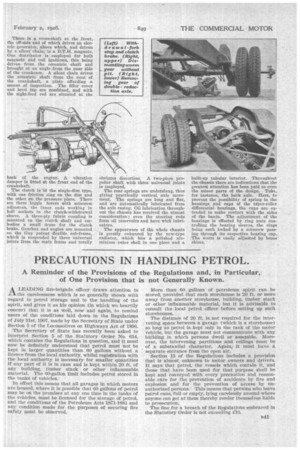• PRECAUTIONS IN HANDLING PETROL.
Page 25

If you've noticed an error in this article please click here to report it so we can fix it.
A Reminder of the Provisions of the Regulations and, in Particular, of One Provision that is not Generally Known.
ALEADING fire-brigade officer draws attention to the carelessness which is so generally shown with regard to petrol storage and to the handling of the spirit, and gives it as his opinion (in which we heartily concur) that it is as well, now and again, to remind users of the conditions laid down in the Regulations of July 31st, 1907, made by the Secretary of State under Section 5 of the Locomotives on Highways Act of 1896.
The Secretary of State has recently been asked to interpret Section 5 of the Statutory Order No. 614, which contains the Regulations in question, and it must now be definitely understood that petrol must not be kept in larger quantities than 60 gallons without a licence from the local authority, whilst registration with the local authority is necessary for smaller quantities if any part of it is in cans and is kept within 20 ft. of any building, timber stack or other inflammable material. The 60-gallon limit includes petrol stored in the tanks of vehicles.
In effect this means that all garages in which motors are housed, where it is possible that 60 gallons of petrol may be on the premises at any one time in the tanks of the vehicles, must be licensed for the storage of petrol, and the conditions of the Petroleum Acts 1871-1881 and any condition made for the purposes of securing fire• safety must be observed.
More than 60 gallons of -petroleum spirit can be stored, provided that each storehouse is 20 ft. or more away from another storehouse, building, timber stack or other inflammable material, but it is advisable to consult the local petrol officer before setting up such storehouses.
The distance of 20 ft. is not required for the intervening space between a garage (which is a storehouse) so long as petrol is_ kept only in the tank of the motor Vehicle, but the garage must not communicate with any building in which persons dwell or assemble. Moreover, the intervening partitions and ceilings must be of a substantial character. Again, it must have a separate entrance from the open air. Section 13 of the Regulations includes a provision that is almost unknown to motor .owners and drivers. It, says that petrol, the vessels which contain it, and those that have been used for that purpose shall be kept and conveyed with every precaution and reasonable care for the prevention of accidents by fire and explosion and for the prevention of access by unauthorized persons. This means that persons who leave petrol cans, full or empty, lying carelessly around where anyone can get at them thereby render themselves liable to prosecution,






























